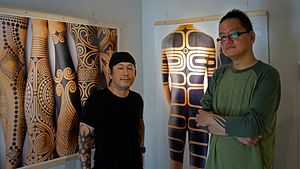(Part two of a two-part story. Part one can be found here.)
At TAV Gallery in the western Tokyo suburb of Asagaya, Charles “Didjelirium” Perez, a well-built Tahitian with tribal tattoos showing on his right leg and chest, stands before a disrobed Japanese man, sitting on his haunches, with a large spiral design splayed across his back. Perez, a Tahitian documentary filmmaker who runs Blackstone Productions with partner Moana Louis, plays a series of evocative notes on an instrument that is a cross between a didgeridoo and a trombone, setting the scene for the traditional tattooing to come.
After the last note sounds, Taku Oshima, a Tokyo-based tattoo artist from Tribal Tattoo Apocaript, sits next to the man, who is now lying face down. As a small crowd looks on, Oshima proceeds to add to the expanding tattoo on his backside, using an old-school wooden-handled tebori, lightly hammering the dark pigment into his skin.
This performance is part of the Jomon Tribe exhibition, produced by Oshima, who focuses on blackwork and tribal patterns, and photographer and journalist Ryoichi “Keroppy” Maeda, a documenter of underground culture around the world since the mid-1990s. The exhibition includes a striking photo series of real tattoos based on hypothetical designs derived from cord markings found on pottery from the Jomon period (14,000-300 BCE). By transposing ancient markings to the human body in the modern age, Oshima and Maeda share a fascinating vision that is part of a larger story.
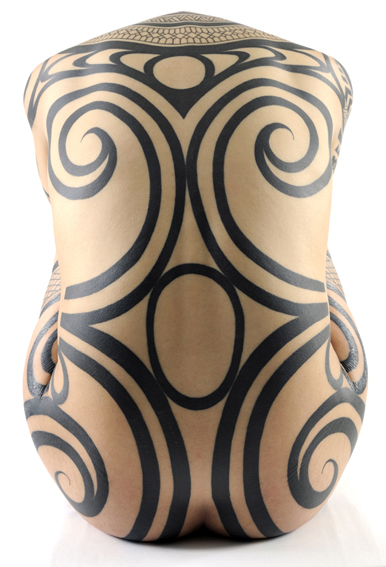
(Tattoo: Taku Oshima; Photograph: Ryoichi Keroppy Maeda)
“Tattooing is a part of culture that tells human history,” Maeda told The Diplomat. “We are promoting this idea in Japan and worldwide by focusing on Jomon-style tattoos.”
The Jomon Tribe exhibition comes at a time when a fresh context for tattoos in Japan is long overdue. As The Diplomat recently explored, the art form has a long, contentious past on the islands. Yet despite social stigma, a growing number of Japanese are inking up. According to The Japan Times, there are around 3,000 tattooists doing business in Japan today, up from only some 200 in 1990. John Skutlin, a PhD candidate in the Department of Japanese Studies at the Chinese University of Hong Kong, places the number even higher, at somewhere between 4,000 and 5,000.
Moreover, social outcasts and gang members are no longer the primary members of society tatting up. Today, Japanese sporting some ink are much more likely to be hip and ambitious. “Many of my clients are self employed, rather than being employees of big companies,” Oshima said. “I view it as illustrating the difference between hunters and farmers. I think tattoos basically come from the culture of a hunting society.”
Skutlin added: “Nowadays, people getting tattoos are more likely to be young people working in fashionable jobs, such as store clerks or beauticians, salarymen, manual laborers, and, quite significantly, non-Japanese.” He pointed out that in her article “Westernization and Cultural Resistance of Tattooing Practices in Contemporary Japan,” Mieko Yamada makes the claim that yakuza clients account for fewer than 50 percent of the total number of those getting inked in Japan today.
“Based on my own research I would put that number quite lower,” Skutlin said. “The image of yakuza as the main clientele of tattoo artists, even those specializing in the wabori style favored by yakuza, does not reflect the reality in which many young people are becoming inked as a fashion statement, and many non-Japanese are coming to Japan to be tattooed by Japanese artists. In fact, last time I was here I met some guys who run a Japanese tattoo travel service, where they arrange tours for people to come to Japan and be tattooed by a Japanese artist.”
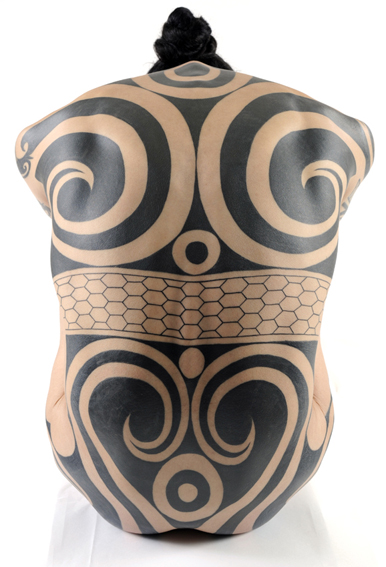
(Tattoo: Taku Oshima; Photograph: Ryoichi Keroppy Maeda)
While tattoo artists may be doing relatively brisk business in Japan today, there is a perennial cry that the art is dying. Attention is usually cast on the fact that there are few remaining tattoo artists with the pedigree of a legendary tattoo artist such as Yokohama-based Horiyoshi III (born Yoshihito Nakano), who has tattooed clients ranging from yakuza members to rock stars over his career spanning more than 40 years. But is a tradition that survived through a centuries-long ban really that likely to die off?
“It’s always interesting to look back and see how often similarly alarmist notions are repeated throughout history,” Skutlin said. “A German journalist showed me his first-edition copy of Tätowieren; Narbenzeichen und Körperbemalen by Wilhelm Joest, in which the author describes in great detail his journey to Japan and the process of getting tattooed there. Interestingly enough, when writing in 1887, he was aware of the Meiji government’s ban on tattooing, and lamented that the art of irezumi might soon die out in Japan.” More recently, Donald Richie and Ian Buruma made similar statements in The Japanese Tattoo, published in 1980, Skutlin pointed out. The esteemed pair of authors wrote: “When the few masters left in Tokyo die, the craft of irezumi will become extinct.”
“Of course, as we can see, the art has not died out, and many young artists have taken up the craft of wabori and tebori,” Skutlin said. “While the traditional apprenticeship system may certainly be in danger of dying out, the technique is still very much alive, and I believe that interest from non-Japanese will help to keep it alive.”
Rather than imminent extinction, the most pressing issue for Japan’s tattoo world today is more likely the possibility that history could repeat itself; namely, through official efforts to reign in the art. During the Edo Period (1603-1868), Japan was under sumptuary laws, which banned tattoos as a forbidden form of luxury. Having inked skin was thought to be “deleterious to public morals.” When the Tokugawa shogunate crumbled, bringing the Edo Period to a close, the emperor was returned to power and the tattoo ban was vigorously enforced in the hopes of presenting a good face to Japan’s new Western visitors. Throughout this long period of prohibition, the art remained underground until General MacArthur’s post-WWII legal reforms lifted the ban, allowing people to show their ink in the light of day for the first time in centuries.
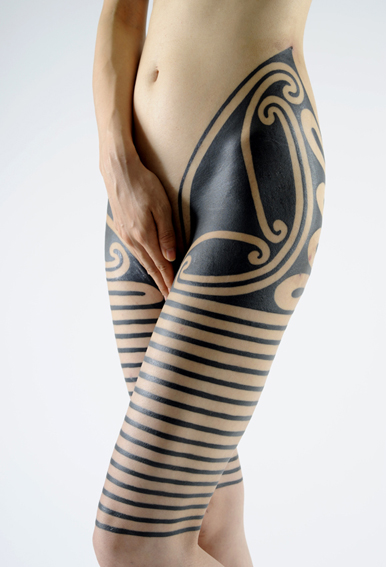
(Tattoo: Taku Oshima; Photograph: Ryoichi Keroppy Maeda)
Although tattoo artists are now free to operate in Japan, an incident happened on September 8, 2015, which sent a chill through the country’s network of ink aficionados. On that fateful day, Taiki Masuda, an Osaka-based tattoo artist, was accused of violating the Medical Practitioners Law (1948), which requires tattooists to be licensed medical practitioners (in theory at least).
Until this incident, the police had drawn a line between tattoo artists who are doing work for yakuza and those who are tattooing the general population. But Masuda’s case calls this status quo into question. In response, concerned tattoo artists and clients have formed an initiative, Save Tattooing, with the aim of protecting the right of tattoo artists to operate in Japan.
“The Save Tattooing movement is a highly contentious issue even among tattoo artists and enthusiasts here, as many feel that litigation, petitioning, and fundraising are only going to cast tattooing in a negative light,” Skutlin said. “However, the fact that tattooing is, while legal, technically punishable under Article 17 of the Medical Practitioners Law, means that some kind of regulatory system is needed to remove it from the current gray area that it occupies in Japanese law.”
As Tokyo gears up for the 2020 Olympics and inbound tourism to Japan has exploded in recent years – with many of those visitors surely tatted up – the current legal status of tattoos is out of sync with the rest of the world. But legal change alone is not enough. The situation calls for a deeper change in perception across society. While this may be a tall order, it’s not without precedent.
A similar revolution took place in the U.S. during the 20th century. This process “has been noted by many scholars of North American tattooing, perhaps most lucidly by Margo DeMello in her book Bodies of Inscription: A Cultural History of the Modern Tattoo Community (2000),” Skutlin said. “It is clear that tattooing gained acceptance through a steady process of popular commodification… and a concomitant systematic repudiation of the ‘crude’ working class tattoos of previous generations. This was the result of numerous factors, including a growing recognition of tribal art and culture as aesthetically significant and improvements in tattooing techniques and hygiene practices.”
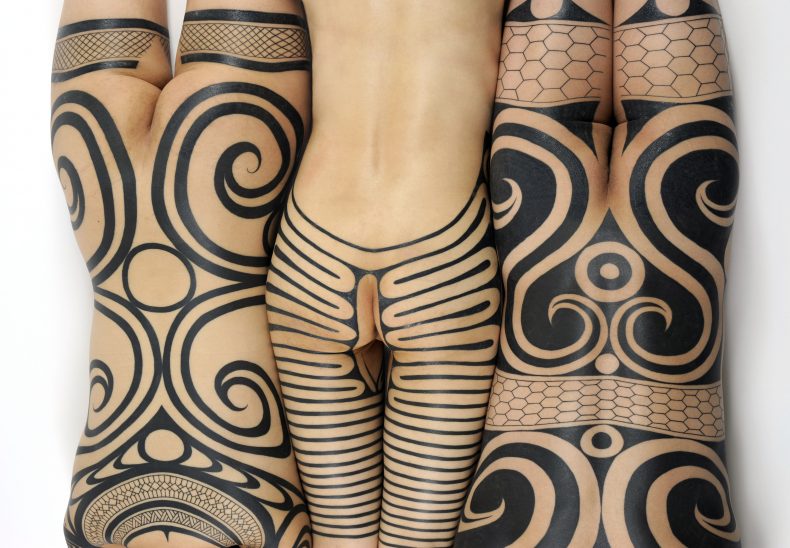
(Tattoo: Taku Oshima; Photograph: Ryoichi Keroppy Maeda)
Could a similar shift happen in Japan?
“Change seems to be happening very slowly, mainly thanks to the younger generation, who is more aware of what’s happening abroad, more open minded and certainly more into self-expression, which tattoos are also a part of,” Perez said. “We are living in the century of the self, the ego is promoted all over, and tattoos are – but not only – a way to identify and differentiate yourself, which is what every young individual aspires to in this social-network governed era.”
This potential sea change would require many factors to push it forward. A major piece of the puzzle would be the influence of pop culture, which “is so influential all over the world, Japan included,” Perez added. “It would only take a proper Japanese tattooed hero to break the darkness surrounding this art. Could that be the first Jomon Man? I’ve already whispered that idea to Taku Oshima and I do hope to help make it become a reality in the near future.”
Whether the Jomon Tribe project will hatch a heavily-inked, next-generation hero or not remains to be seen. But at the very least, it could spark dialog and add another shade of nuance to the discussion surrounding tattoos in Japan.
“I hope our Jomon project will help people better understand tattoos,” Oshima said. “Tattoos are fun. This is what I want say to everybody, no matter where they are from in the world.”













